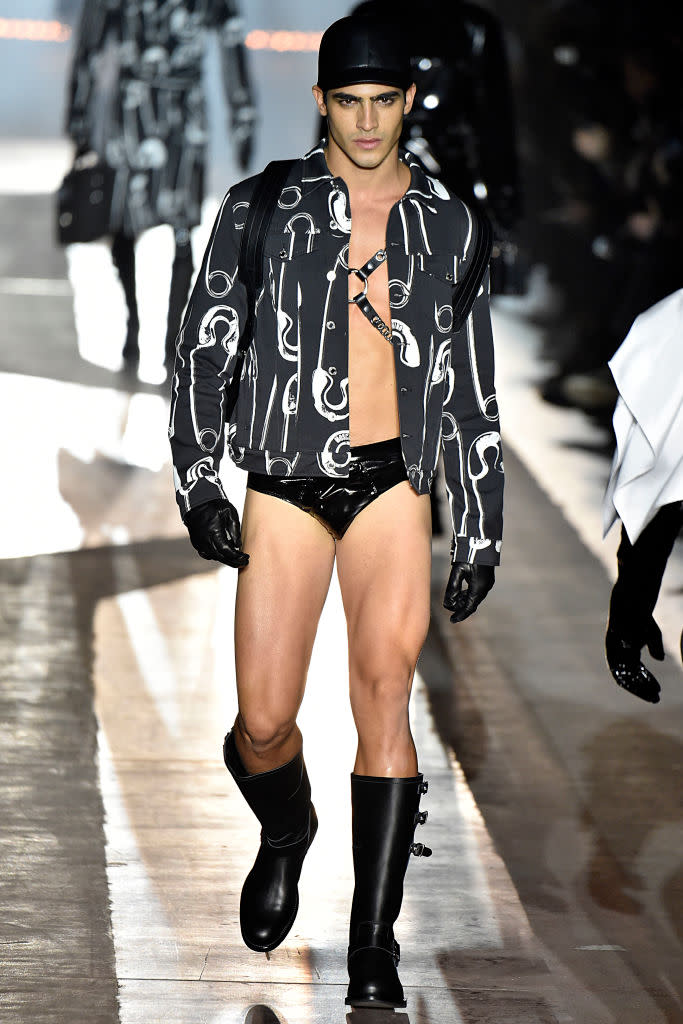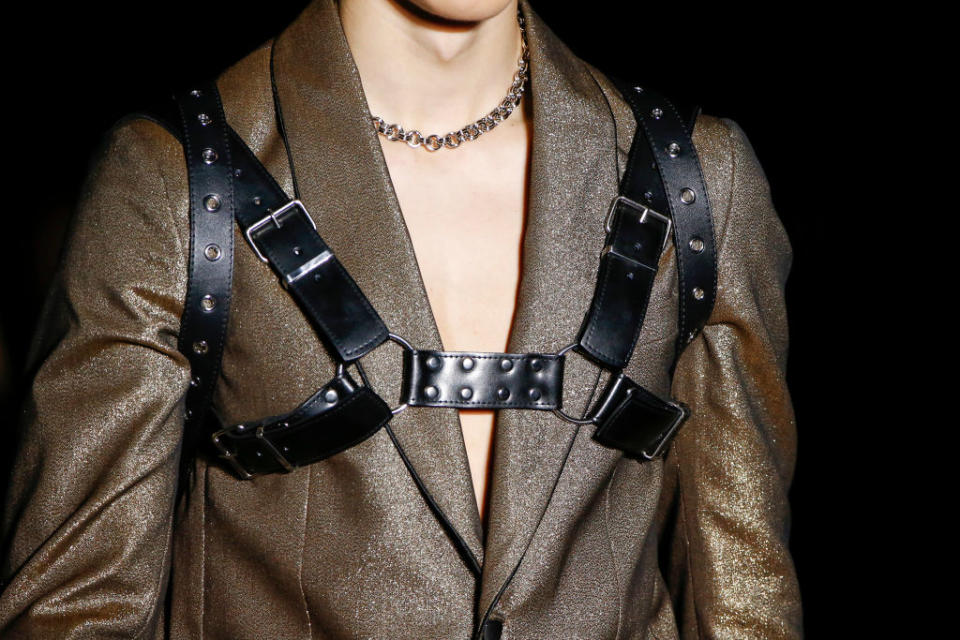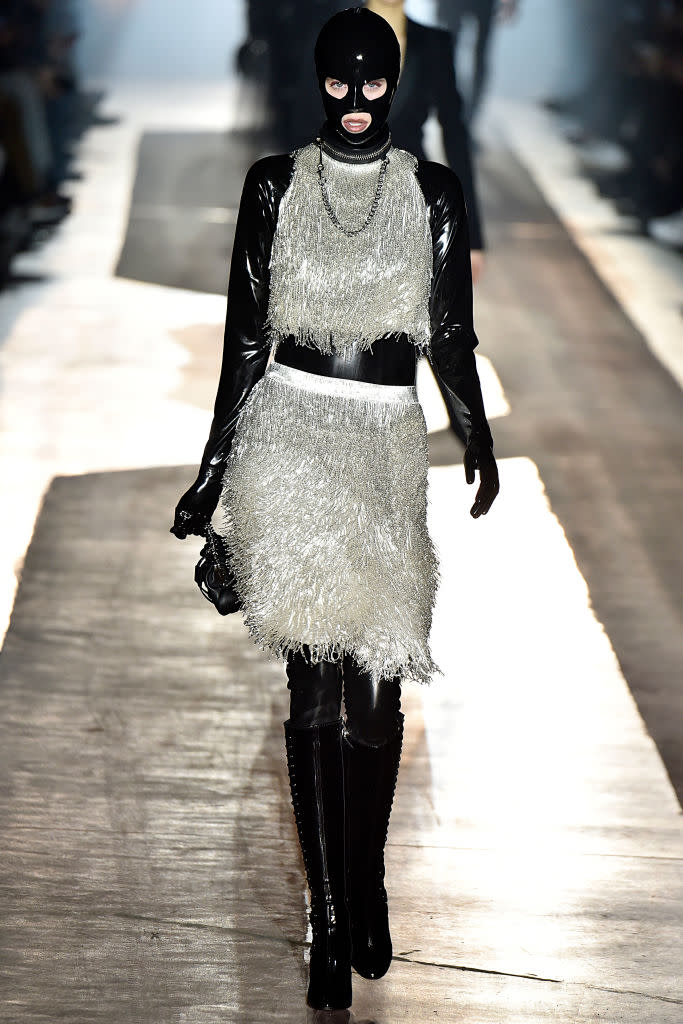Jeremy Scott's bringing fetishism back to fashion

Usually when we say that something is “back,” the implication is that it went away. In the case of Justin Timberlake bringing sexy back in 2007, he was lampooned for unwittingly suggesting that sexy had somehow disappeared from the American cultural landscape — a laughable proposition, given that the mid-aughts were defined by jeans so low that thong underwear never stood a chance. But Jeremy Scott, presenting his new line for Moschino’s fall 2018 menswear collection, definitely brought fetish back to fashion, where its inextricable historical ties have been largely quiet over the past decade.
In the world of couture, the mid-aughts focused on romanticism. Alexander McQueen had already come into his own as a theatrical luminary. Valentino passed down his namesake brand into the capable hands of Maria Grazia Chiuri and Pierpaolo Piccioli. Under the leadership of these bright houses, high fashion became the stuff of princess dreams: heavily embroidered couture ball gowns, floor-sweeping hems, and tons of sheer tulle embellished with exquisite beading. No designer was more in the throes of romanticism than Riccardo Tisci, whose couture collections for Givenchy made beadwork appear as though it were levitating around the body.
Fashion has been obsessed with all things saccharine since then, but Scott balled up the tulle and replaced it with latex. His models paid homage to fashion’s primary influences in the ’80s and early ’90s: queer culture and the BDSM fetishists of its underground.
Scott took signifiers of the scene like tall boots and leather harnesses and paired them with destroyed boardroom apparel and had waistcoats with sleeves attached by suspenders, a wink to Charlotte Rampling in The Night Porter.

There were other outright references to fetishes. Scott tackled rubber dolls, a fetish that involves dressing up feminine forms with latex clothing. Rubber dolls often wear full catsuits with holes only for seeing, breathing, and tasting; the excitement lies in the wearer-as-object, devoid of any identity markers. They are anonymous sexual cyborgs, subservient in their latex skin, still organic with curves and eyes. Scott may have decked out one of his rubber dolls in a ruffled satin jacket, but her catsuit was the unmistakable sexual dog whistle.
Scott’s collection also harked back to the days when queer men enjoyed fetish as part of gay culture — the two being conflated by necessity because they had few places to be in the open. A male model walked the runway in shiny patent underwear, riding boots, and a police-style hat — a look that would not be out of place at a British new wave queer night, though it feels refreshing after years of menocore.

Of course, Scott was building upon the work of visionaries like Shayne Oliver of Hood By Air, whose deconstructed suiting tears at the very notion of masculinity, a questioning that has roots in queer communities of color. Zana Bayne’s leather harnesses and accessories are as functional as they are glamorous, though you’d be hard-pressed to find an editor who’d admit to using them for their, well, intended purpose. Fetish, privately commonplace as it is, is still considered too taboo to even discuss.
The fetish scene still exists today, although designers are hardly scanning FetLife for moodboard photos. The last time BDSM was seriously referenced in fashion was when Jean-Paul Gaultier escorted Dita Von Teese down the runway in 2010, the burlesque queen wearing a gilded black harness shaped like a skeleton.
As always, it’s the queer community at the forefront; Brooklyn’s BDSM-lite Bound parties are strictly intended for a queer audience, a community for whom fetish was both an aesthetic choice and a means for survival. But Scott, with his lust-worthy laced knee-high boots and corsets, reminds us that the kinky world is still there, waiting for its chance to become en vogue again. Like anything that comes in and out of style, it never goes completely away — it just waits to be rediscovered by an appreciative audience.
Read more from Yahoo Lifestyle:
Follow us on Instagram, Facebook, and Twitter for nonstop inspiration delivered fresh to your feed, every day.


